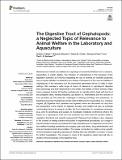Por favor, use este identificador para citar o enlazar a este item:
http://hdl.handle.net/10261/313127COMPARTIR / EXPORTAR:
 SHARE
BASE SHARE
BASE
|
|
| Visualizar otros formatos: MARC | Dublin Core | RDF | ORE | MODS | METS | DIDL | DATACITE | |

| Título: | The Digestive Tract of Cephalopods: a Neglected Topic of Relevance to Animal Welfare in the Laboratory and Aquaculture |
Autor: | Sykes, A.V.; Almansa, Eduardo; Cooke, G.M.; Ponte, Giovanna; Andrews, P.L.R. | Palabras clave: | cephalopods Acuicultura Centro Oceanográfico de Canarias digestive tract Directive 2010/63/EU Octopus vulgaris Sepia officinalis welfare |
Fecha de publicación: | 2017 | Citación: | Frontiers in Physiology, 17. 2017: 1-16 | Resumen: | Normal development, growth and the maintenance of health and well-being are only possible if all the digestive tract functions (e.g., motility, digestion, and absorption) operate normally and in concert. Understanding the physiological processes and the impact of external factors (e.g., handling, temperature, diet quality including exposure to food toxins, exposure to viral/bacterial infections and parasites) is important for normal laboratory maintenance of the animal in a research setting, as well as for optimizing conditions for aquaculture at each life stage. The study of the physiology of the cephalopod digestive apparatus has mainly focused on Sepia officinalis (Bidder, 1966; Boucaud-Camou and Boucher-Rodoni, 1983; Mangold and Bidder, 1989; Quintela and Andrade, 2002a,b; Sykes et al., 2013; Costa et al., 2014), Octopus vulgaris (Boucher-Rodoni and Mangold, 1977; Boucaud-Camou and Boucher-Rodoni, 1983; Andrews and Tansey, 1983b; Mangold and Bidder, 1989), Octopus maya (Martínez et al., 2011a,b, 2012; Rosas et al., 2013; Linares et al., 2015; Pech-Puch et al., 2016). Few studies have been carried out in Loligo vulgaris and other squid (Bidder, 1950; Mangold and Bidder, 1989). Furthermore, the morphology, motility and absorptive functions of the digestive tract of Nautilus pompilius have been the subject of limited investigation (Westermann and Schipp, 1998a,b, 1999; Ruth et al., 1999; Westermann et al., 2000, 2002). The inclusion of all “live cephalopods,” taken to mean all living species (about 700), at all life stages after hatching, in Directive 2010/63/EU (European Parliament and Council of the European Union, 2010) covering the use of animals in scientific research and education poses a number of challenges for research (Smith et al., 2013; Fiorito et al., 2015) including that aimed at optimizing practices in aquaculture (Sykes et al., 2012; Smith et al., 2013; Fiorito et al., 2015). Whilst the Directive regulates studies in the Member States of the European Union, the principles it enshrines and the approaches to care and welfare required for compliance are likely to impact on cephalopod research outside the European Union (see Fiorito et al., 2014, for discussion of wider implications). In comparison to the commonly studied vertebrate laboratory species and commercially exploited vertebrates such as salmon and trout, chickens, cows, and pigs (Stevens, 1988; Grosell et al., 2010; Rønnestad et al., 2013), knowledge of the physiology of the cephalopod digestive tract at all life stages is limited. Cephalopods are also kept for education and display purposes and, as in the laboratory and aquaculture, the normal functioning of the digestive tract is essential for good health and wellbeing (Fiorito et al., 2015). In this review, we will highlight a number of specific aspects of the relationship between feeding behavior and the physiology of the cephalopod digestive tract where increased understanding is required to ensure animal welfare. We will also discuss areas where further study is required. | Versión del editor: | http://journal.frontiersin.org/article/10.3389/fphys.2017.00492/full | URI: | http://hdl.handle.net/10261/313127 |
| Aparece en las colecciones: | (IEO) Artículos |
Ficheros en este ítem:
| Fichero | Descripción | Tamaño | Formato | |
|---|---|---|---|---|
| Sykes-17-Welfare cephalopods .pdf | 436,72 kB | Adobe PDF |  Visualizar/Abrir |
CORE Recommender
Este item está licenciado bajo una Licencia Creative Commons

